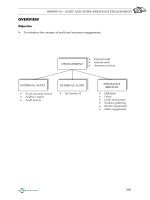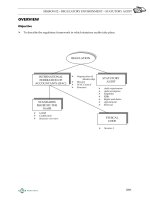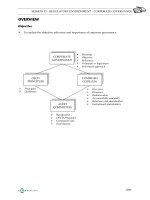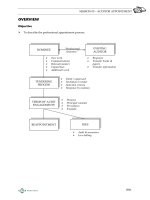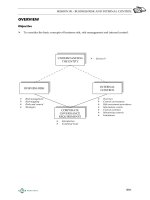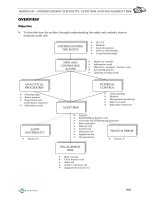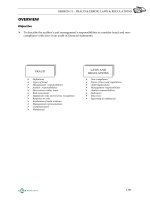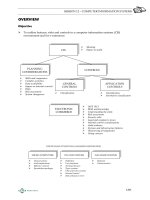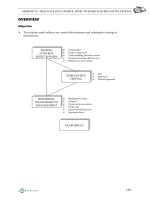ATC f8 materials FF8 AA (int)session25 j08
Bạn đang xem bản rút gọn của tài liệu. Xem và tải ngay bản đầy đủ của tài liệu tại đây (297.66 KB, 12 trang )
SESSION 25 – LOANS, BANK AND CASH
OVERVIEW
Objective
To determine areas of risk in the audit of loans, bank and cash.
To obtain appropriate audit evidence including bank reports for audit purposes.
“Ideas list”
Examples
SOURCES OF
EVIDENCE
CASH
SYSTEM
Control objectives
Internal control
examples
Loans
Bank and cash
RISKS
PROCEDURES
Loans
Bank reconciliation
C
A
Standard letter
BBA
Authority to disclose
P
BANK REPORTS
FOR AUDIT
PURPOSES
E
R
Form
Standard request
Supplementary info
Disclaimers
A comprehensive audit program for bank and cash balances (including counting of “petty”
cash) is set out in Appendix 3 and must be studied.
2501
SESSION 25 – LOANS, BANK AND CASH
1
SOURCES OF EVIDENCE
Example 1
Complete the following ideas list for bank and cash balances.
1.1 “Ideas list”
1.2 Examples
Accounting systems
⇒
Documentation
⇒
Tangible assets
⇒
Management and employees
⇒
Customers and suppliers
⇒
Other third parties
⇒
Analytical procedures
⇒
2
CASH SYSTEM
2.1
Control objectives
To ensure that . . .
Stage 1
Request for payment
. . . payments are only requested for
valid business expenses.
Stage 2
Payment authorisation
. . . payments are accurate and take
advantage of credit terms.
Stage 3
Payment made
Stage 4
2502
Receipt
Payments and receipts
recorded
. . . cash/cheques are not
misappropriated.
. . . management has
accurate/timely info concerning
cash position..
SESSION 25 – LOANS, BANK AND CASH
2.2
Internal control examples
2.2.1
Request for payment
Standardised cheque requisitions
Supporting documentation (e.g. invoice)
2.2.2
Payment authorization
Departmental/buyer approval
Agreement to suppliers’ statement
2.2.3
Payment made/Receipts
Safe custody of cheque books
Invoices/requisitions stamped “PAID”
2.2.4
Recording
Segregation of duties
Monthly bank reconciliations
Supervision/independent review
3
RISKS
3.1
Loans
Loans may be obtained without authorisation/in contravention of existing agreements.
Loans may become repayable on demand due to breaches of agreements.
Secured, unsecured and inter-company loans may not be separately disclosed.
Loan interest may not be accrued.
3.2
Bank and cash
Most liquid assets may be exposed to misappropriation.
Secured assets may not be separately disclosed.
Cheques raised in bulk at y/e may be subsequently cancelled or their despatch
unacceptably delayed.
Cash receipts may be stolen and difficult to trace.
Cheque payments may be misappropriated by forging endorsements if not crossed “a/c
payee”.
2503
SESSION 25 – LOANS, BANK AND CASH
4
AUDIT PROCEDURES
4.1
Loans
Examine the loan agreement noting:
term of the loan;
rate of interest (fixed or variable);
security given;
repayment terms.
Obtain schedules of the loan(s), reconciling opening balances, movements in year and
closing balances.
Confirm redemptions during the year by reference to:
authority (e.g. board minutes);
paid cheques and cash book entries;
the calculation of any discount or premium;
accrued interest paid;
deletions in the register of holders of loans.
Verify any fresh loans/debentures issued by reference to:
trust deed;
receipt of monies in cash book and general ledger;
entries in register.
Obtain direct confirmation from lenders.
Agree reconciliation of opening and closing balances, statement of financial position
figures and comparatives.
Scrutinise statutory books (if any) and confirm that they are correct regarding:
changes in assets;
directors’ interests in debentures.
Re-compute interest charge and interest accrual calculations.
Agree disclosure of long-term liabilities in accordance with financial reporting
framework. For example:
secured loans excluding portion repayable within one year;
unsecured loans excluding portion repayable within one year;
summary of interest rates, repayment terms, covenants;
security given.
2504
SESSION 25 – LOANS, BANK AND CASH
4.2
Bank reconciliation
4.2.1
Purpose
To check the completeness and accuracy of cash book postings by “reconciling” the
balance per the cash book to the balance per the bank statement (prepared by an
independent, third party – the bank).
At any time, the bank statement balance should equal that in the cash book, albeit “in
reverse”. However, the cash book balance invariably does not agree with the bank
statement. This is caused principally by timing differences (see below).
4.2.2
Bank statement balance
Entity’s perspective
Bank’s perspective
Dr balance in cash book is an
asset
“Cr” balance on bank statement
means customer is a creditor (i.e.
bank owes customer)
Cr balance in cash book means
“overdrawn” (i.e. a liability)
4.2.3
“Dr” means customer owes the
bank (i.e. is overdrawn)
Reasons for differences
Unpresented cheques (i.e.
cheques drawn by the business)
Timing differences
Outstanding lodgements (i.e.
receipts “lodged” with the bank)
Bank interest/charges
Standing orders (“SOs”)/
direct debits (“DDs”)
Items on bank statement not in cash book
Credit transfers
Dishonoured (“bounced”) cheques
Bank errors
Cash book errors
−
−
−
−
cast errors
transpositions
omissions
duplications
2505
SESSION 25 – LOANS, BANK AND CASH
Commentary
Cheques
A cheque is a “money order” drawn (i.e. written out) by a payer to settle an
amount due to the payee. The payee presents the cheque to a clearing bank to
have the money transferred to the payee’s account. If the payer does not have
sufficient funds to cover the payment then the cheque is returned to the payer
as “dishonoured” and the transfer to the payee is reversed. The payer’s
liability is not discharged and the payee must ask for payment again.
There are many other reasons why a cheque might be dishonoured e.g. if:
it is post-dated (i.e. drawn for payment at a late) or out of date (usually
after 6 months)
there is a discrepancy between the amounts written (in narrative and
numerically)
the account has been closed or cannot be traced
the payer has put a “stop” on the cheque.
The bank usually charges the payer a service cost for handling such cheques.
Direct debit
An authority given by a payer to a third party (the payee) to debit the payer’s
account on a specific date (or nearest banking day thereto). This authority can
be:
for a fixed amount per month (e.g. a loan repayment) or
variable (e.g. payment of a telephone bill where the amount is only known
at the end of the billing period).
Standing order
Instructions given by a payer to their Bank to pay a fixed amount on
predefined dates to a third party (who has no power to request payment from
the bank).
4.2.4
Reconciliation procedure
Step 1
Correct/amend cash book – requires double entries.
Step 2
Adjust bank statement balance for
−
−
2506
timing differences
bank errors.
SESSION 25 – LOANS, BANK AND CASH
4.2.5
Proforma
XYZ Bank reconciliation as at . . . . .
Step 1
Cash a/c
The fact that
these do not
agree
suggests
something
has occurred
which needs
reconciling
Opening balance b/f
Adjustments
eg interest received
$
x
x
__
Adjustments
eg dishonoured cheque
Balance c/f
Balance per bank statement
Add: Uncleared lodgements
x
x
__
x
__
Bank reconciliation statement
$
x
__
$
$
x
x
__
x
__
Less: Unpresented cheques
4.2.6
x
__
x
+/– Bank errors
(x)
x
__
Balance per corrected cash account
x
__
These
should
now
agree.
This
balance
⇒
balance
sheet
Adjust CB
for all
errors,
timing
differences
or
omissions
⇒
up-to-date
balance.
Step 2
Reconcile
adjusted
balance to
bank
statement,
noting
cheques in
transit,
bank
errors, etc.
Summary of audit procedures
Confirm balance per the bank statement (e.g. to the bank report for audit purposes) and
agree cash book balance to the general ledger.
Check the reconciliation casts (i.e. adds up).
Agree uncleared (“outstanding”) lodgements and unpresented cheques to entries on the
bank statement dated after the end of the reporting period.
A comprehensive audit program for bank and cash balances (including counting of “petty”
cash) is set out in Appendix 3 and must be studied.
2507
SESSION 25 – LOANS, BANK AND CASH
5
BANK REPORTS FOR AUDIT PURPOSES
Commentary
Also called “bank (confirmation) letter”.
Role as Audit evidence:
−
−
existence and amount of liabilities;
existence, amount, ownership and custody of assets.
5.1
Standard letter
Facilitates extraction of information
Smoothes the processing of requests
Answers received highlight particular areas for further work.
5.2
British Bankers Association (BBA)
BBA membership includes banks around the world (e.g. Amex, Moscow Narodny,
Zivnostenska).
Instead of the bank confirmation request letter containing an exhaustive list of all the
possible information which could possibly be required, the auditor simply ticks ( ) for a
“Standard request” and/or supplementary information.
5.3
Authority to disclose information
May be
ongoing “standing” authority
separate authority for each request.
Addressed to the bank.
Names all group entities.
“I/We authorise [Bank] including all branches [and subsidiaries] to provide to our
auditor [Accountants] any information that they may request from you regarding all
and any of our accounts and dealings with you.”
Authorisation signature(s) for all entities.
2508
SESSION 25 – LOANS, BANK AND CASH
5.4
Form
Send letter on own paper
↓
BANK CONFIRMATION REQUEST LETTER
Send to every
bank the client
has dealt with
during year →
(Branch where
client has
main business
arrangement)
No contractual
relationship →
XYZ and Co
17 Kendall Drive
11 December 2006
The Manager,
.................................................. (Bank)
................................................. (Branch)
← to reach bank at
least 2 weeks
before y/e
Dear Sirs
In accordance with the agreed practice for provision of information to
auditors, please forward information on our mutual client(s) as detailed
below on behalf of the bank, its branches and subsidiaries. This request
and your response will not create any contractual or other duty with us.
Companies (or other business entities)
Names of entities
[Parent Company
covered by →
Subsidiary 1
request
Subsidiary 2]
FOR THE YEAR ENDED 31 DECEMBER 2006
Information required
Tick
← Use standard
request letter
Attach a separate
← listing if
necessary
← “Audit
confirmation date”
Standard
Trade finance
Derivative and commodity trading
Custodian arrangements
Other information (see attached)
Explicit
→
authority to
disclose from
client
The Authority to Disclose Information signed by your customer is
attached/ already held by you (delete as appropriate). Please advise up if
this Authority is insufficient for you to provide full disclosure of the
information requested.
The contact name is [xx]
← Banks may
charge clients a
premium for
supplementary
info
← Request to be
advised
Telephone [xxxx xxx xxxx]
Yours faithfully
XXX Accountants
5.5
Standard request
Balances on a/cs (including loans, joint a/cs and trade name a/cs)
Facilities – loans/overdrafts/guarantees etc (including term, repayment, review date,
limit, etc).
Securities (including set-off arrangements).
Additional banking relationships – not covered by above.
2509
SESSION 25 – LOANS, BANK AND CASH
5.6
Supplementary information
Trade finance – including letters of credit, acceptances, bills, bonds, guarantees and
indemnities (and security thereon).
Derivatives and commodity trading – including foreign exchange contracts, forward
rate agreements, financial futures, swap arrangements and option contracts (and
security thereon).
Custodian arrangements – the nature and quantity of any assets held but not charged
(e.g. title deeds held for safe-keeping rather than securing a mortgage).
Other information – copy bank statements/paying-in slips, returned paid cheques,
“stopped” cheques.
5.7
Disclaimers
“Our response is given solely for the purposes of the audit and creates no responsibility to
the auditors.”
Does not significantly impair the value of information given as audit evidence.
Therefore entitled to rely, unless clearly wrong, suspicious, inconsistent, etc.
FOCUS
You should now be able to:
identify risks and appropriate sources of evidence;
suggest cash control objectives and recommend internal control procedures;
describe methods used to collect audit evidence to verify loans, bank and cash
(including the bank reconciliation);
state the standard information requested in a bank confirmation request letter;
select appropriate audit procedures (including bank confirmations and reconciliations)
for inclusion in a work program (see also Appendix 3) relating to financial statement
assertions concerning bank and cash.
2510
SESSION 25 – LOANS, BANK AND CASH
EXAMPLE SOLUTION
Solution 1 — “Ideas list”
Accounting systems
⇒
Cash system, cash book(s), “imprest” for
petty cash
Documentation
⇒
Cheque requisitions
Tangible assets
⇒
Physical cash (count it)
Management and employees
⇒
Board minutes (authorising cheque
signatories), cashier
Customers and suppliers
⇒
Possibly DD or SO mandates for expenses
(e.g. insurance premiums)
Other third parties
⇒
Bank statements, report for audit purposes
(= “confirmation letter”)
Analytical procedures
⇒
“Proof in total” – interest
payable/receivable (calculation based on
month-end balances)
2511
SESSION 25 – LOANS, BANK AND CASH
2512
